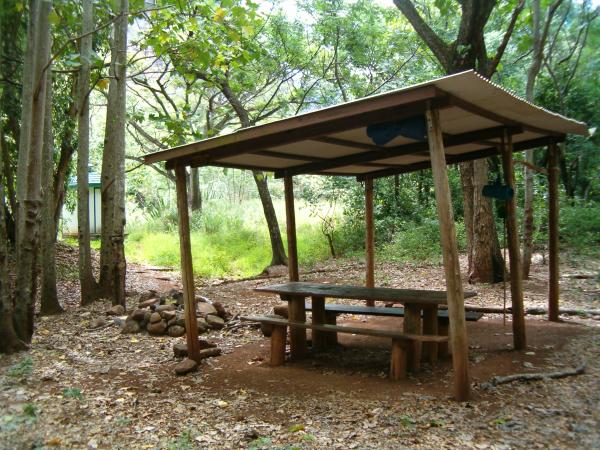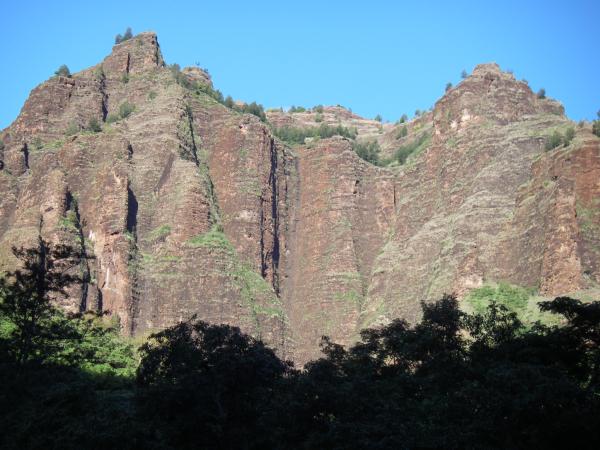In an email, Brian asks:
My wife and I will be visiting the island for a little over two weeks from the end of December-January, and except for a couple of days at the beginning and the end of our trip, we’d love to spend the rest away from the crowds, in our tent, soaking in as much nature as possible.
We’re definitely going to do the Kalalau hike; are there other “must do” multi-day hikes on the island? If so, how would you prioritize them?
While Kauai has a vast interior mostly untouched by people, it does not have a network of hiking trails like other wilderness areas on the mainland. There are many reasons for this:
- Several large valleys such as Wainiha or Olokele Canyon are private land-holdings, making them off-limits.
- Other areas are too steep to create trails that wouldn’t erode.
- Some areas such as the Alaka’i swamp are too fragile ecologically to support much human intrusion.
- Also, the interior is much wetter than the coast, meaning the trails would be expensive to maintain and not very popular.
- Finally, hunting is permitted in many areas around the island, further dissuading many hikers.
While never a pre-contact Hawaiian practice, hunting has become engrained in local culture now, either as sport or as sustenance. I’m sure that hunters outnumber recreational hikers on Kauai, and certainly they outnumber recreational backpackers. As a result, all of the backcountry campsites outside of Kalalau and the Na Pali coast are hunters’ camps, and the trails to access them are mostly used by hunters.

Only camp under the roof in case of a big storm, otherwise find a flat spot nearby
Because of the wetness factor, these camps and trails are mostly located in the Waimea Canyon area that tends to be drier. There are also a few in Kokee due to the rich hunting grounds up in the forest. These camps all have a roof shelter and sometimes a table. While many hunters use other trails on the east side such as the Powerline or Tunnels hike, there are no established camps on them.
Here are the possible overnight hikes and backcountry campsites that I know of:
- The one most worth doing is to hike down into Waimea Canyon and following the river down to Waimea Town. You can do this as a 10-mile single-day hike, but staying overnight lets you break it up and have time to explore. The trail is fairly good and not difficult, but there are several river crossings so you cannot go when rains or storms will create flash-flood conditions.
When you go down the Kukui trail into the canyon, there are two camps on the Waimea river, two in the Koaie side-canyon, and one near the Waialae side-stream. Koaie is upstream, so you could hike up there the first day after setting up your tent in Wiliwili camp right at the bottom of the Kukui trail. With an early start the next day, you would catch the beautiful morning light in the lower canyon, and still reach the road-end by early afternoon.

Looking up to the west rim lit by the morning sunFrom the road, it’s 2 miles to Waimea Town past the Menehune ditch and the swinging bridge, so you either have to have a car shuttle set up or take your chances hitch-hiking back up to the Kukui trailhead. You cold also camp at Lucy Wright county campground in Waimea Town and set out the next day back up to your car, either hiking along the canyon rim road, or again hitch-hiking.
- There is a trail called the Mokihana Stream route on the east side of Waimea canyon, on a ridge that eventually goes up to the forest highlands. There is a cabin in the forest, called Waialae cabin on Waialae stream far above Waialae falls that are visible from the Kukui trailhead. The cabin is over 15 miles from the end of the road at the bottom of the canyon, but there are several shelters at lesser intervals along the ridge that would make a fine camp.

Waialae stream and cabin in the late afternoon, after a long day of hikingThis is an out-and-back hike, but the views will be up into Waimea canyon one way and out to sea going back. To the east is the rarely seen Olokele canyon. The only problem with the Mokihana Stream route is that it is misnamed and remains on the ridge with no access to water other than catchment tanks from the shelter roofs (water availability is therefore uncertain, and purification is a necessity).

Backcountry shelter on the Mokihana Ridge - Kawaikoi Camp and Sugi Grove are located on the Mohihi-Camp 10 dirt road that begins in Koke’e state park. They are heavily used by hunters who drive in with their trucks, mostly on weekends. It should be relatively quiet during the week, but you should double-check by calling the Koke’e museum. I believe these two camps have toilets, but you should confirm that too.
You could drive in yourself if you have a 4×4 or hike in on the road. You could also hike in or out on the Pihea trail from the 2nd Kalalau lookout or any number of trail and road combinations from the main parking lot at the Koke’e museum and lodge. Once there, you could use it as a base to explore further canyon-side on the Kohua Ridge Trail or into the forest on the Mohihi trail (be very careful with your route-finding on that one). The Koke’e museum sells a small map with most of these trails, and they should be able to give you updated trail conditions.
These camps and trails are open to everyone, no hunting permit is required. You do need a camping permit that is free and easily obtained from the state Department of Land and Natural Resources (DLNR: 3rd floor of the state building in Lihue). Like other campsites there might be quotas, but I’ve never had trouble reserving, even for a weekend night. Anyways, they can tell you if another party, most likely hunters, have registered, in which case you may want to choose another camp to have peace and quiet.
Camping in the backcountry anywhere outside of these designated campsites is illegal, according to the DLNR. I’m sure there are many illegal hunter campsites all around the island, and I have seen places you could easily hide a tent off most of the trails. However, I don’t think visitors can plan any multi-day hikes without knowing were camping is possible, so I think it’s best to have local knowledge before trying to sneak around like that.
While hiking, camping and hunting can and do co-exist on Kaua’i, non-hunters should be prepared to respect, or at least put up with, local hunting practices. I have seen hunters shooting at goats from the trail. The worst is a habit of leaving animal carcasses to rot near campsites, not to mention lots of litter, sometimes even bags of trash. The only thing you can really do about it is look further for a tent-site, or go to the next camp. Remember, these backpacking opportunities probably exist only because of the hunters in the first place.
One last bit of advice: you can also set up a base camp at the county campgrounds, which are all beach parks, and do day-hikes on all the regular trails. That requires a rental car, but you would need to get one anyways. This is how I visited Kaua’i for the first time, what better way to discover the island than by camping at all the beaches.
Thank you so much for your informative article. Really gives us insight into your beautiful land. Allows us to understand it and respect it all that much more.
Brian.
What a great site! I’m so glad I found you as I am planning a trip to Kauai next month and was looking for info on the hikes on the island. You were like a gift from the gods! It sounds like such a beautiful place and I can’t wait to explore it. Thanks. Nicci
Aloha, I’m visiting from Maui and trying to just camp. Wondering if you can just camp at the beach parks and the ranger will collect your payment or do I need to arrange permits for beach parks ahead of time. It goes both ways in Maui.
Thanks for the help,,, this is really good info. Mahalos
Thanks for the background info and tips. Do you know where I can get detailed trail maps to plan hiking trips in Kauai?
I’m not interested in guided hikes.
All this outline is 10 years old. Sure wish writers would start off VERY FIRST THING by entering a posting date, providing context. The date is everything. Anyways, camping is longer permitted along the Kukui trail.
You have to wonder what the worldwide garbage bin will look like in 100 years with all this old outdated information posted — web pages should be set to expire.
Hi, you’re right, this article is from November 2007. The blog used to automatically put the date under the title, now it appears only is small print at the end of the article. Not as helpful, so I’ll see what I can do to make it more prominent.
Did you mean that camping is no longer allowed along the Mokihana route? The biggest update to this post is that all campsites managed by the DLNR (state Division of Land and Natural Resources) are now reserved online. This includes the state parks (Kalalau/Na Pali coast, Koke’e, Polihale, and these in the Waimea Canyon). That website shows the Wiliwili camp on Kukui trail still open, as are all the ones upstream to Lonomea on the Koaie stream. But indeed the campsite shelter on the Mokihana Ridge (second bullet in the article, photo with water tank) is not in the reservation system and thus not open to camping. The Waialae cabin is open for reservations, but it is very difficult to reach on uncertain trails.
Thanks for the corrections, I will need to update this article or rewrite it for current conditions one of these days.